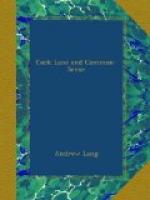Writers on Psychology sometimes make a push at a theory of haunted houses. Mr. James Sully, for example, has done so in his book styled Illusions. {153} Mr. Sully appears well pleased with his hypothesis, and this, granting the accuracy of a tale for which he is indebted to a gentleman who need not be cited here, argues an easily contented disposition. Here is the statement:—
’A lady was staying at a country house. During the night and immediately on waking up she had (sic) an apparition of a strange-looking man in mediaeval costume, a figure by no means agreeable, and which seemed altogether unfamiliar to her. The next morning, on rising, she recognised the original of her hallucinatory image in a portrait hanging on the wall of her bedroom, which must have impressed itself on her brain before the occurrence of the apparition, though she had not attended to it. Oddly enough, she now learned for the first time that the house at which she was staying had the reputation of being haunted, and by the very same somewhat repulsive-looking mediaeval personage that had troubled her inter-somnolent moments. The case seems to me to be typical with respect to the genesis of ghosts, and of the reputation of haunted houses.’
This anecdote affords much joy to the superstitious souls who deal in Psychical Research, or Ghost Hunting. Mr. Sully’s manner of narrating it clearly proves the difference between Science and Superstition. For a Ghost Hunter or Psychical Researcher would not venture to publish a modern ghost story (except for mere amusement), if he had it not at first hand, or at second hand with corroboration at first hand. Science, however, can adduce a case without indicating the evidence on which it rests, as whether Mr. Sully’s informant had the tale from the lady, or at third, fourth, fifth, or a hundredth hand. So much for the matter of evidence. Next, Mr. Sully does not tell us whether the lady ‘had an apparition,’ when she supposed herself to be awake, or asleep, or ’betwixt and between’. From the phrase ‘inter-somnolent,’ he appears to prefer the intermediate condition. But he does not pretend to have interrogated the lady, the ‘percipient’. Again, the figure wore a ‘mediaeval costume,’ the portrait represented a ’mediaeval personage’. Does Mr. Sully believe that the portrait was an original portrait of a real person? and how many portraits of mediaeval people does he suppose to exist in English country houses? Taking the Middle Ages as lasting till the beginning of the reign of Henry VIII., say till Holbein, we can assure Mr. Sully that they have left us very few portraits indeed. But perhaps it was a modern picture, a fanciful study of a man in mediaeval costume. In that event, Mr. Sully’s case is greatly strengthened, but he does not tell us whether the work of art was, or was not, contemporary with the Middle Ages. Neither does he tell us whether the lady was in the habit of seeing hallucinations.




